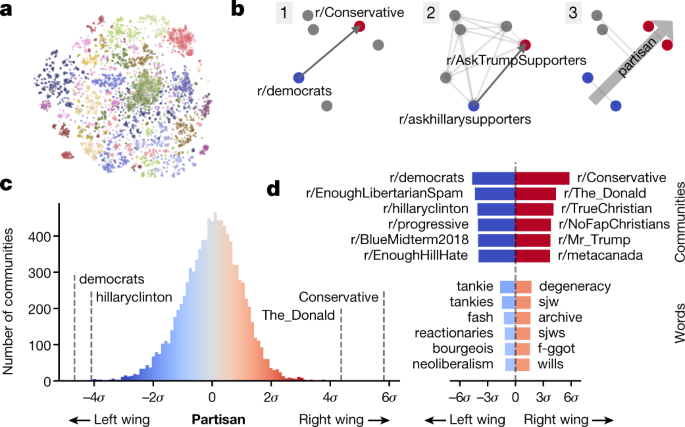(a) The partisan distribution of deleted and non-deleted comments in political communities. (b) The proportion of activity that took place in very left-wing ((z 3)) communities over time. (c) Alternate version of Fig. 3a generated using a dataset in which the authorship of all comments was randomly shuffled. Each individual bin distribution is extremely similar to the overall activity distribution, showing that the overall activity distribution is a useful reference point for what bin distributions would look like if there were no tendency for users to comment in ideologically homogeneous communities. (d) Average distributions of political activity for authors of comments in the 25 largest political communities on Reddit (by number of comments). (e) Correlation of users’ average partisan scores over time. Each (left(x,yright)) cell represents the correlation between scores of a user in month ({t}_{x}) and that same user in month ({t}_{y}), for all users active in both time periods. A user is only considered active if they make at least (10) comments in a month. (f) The relationship between the proportion of users who polarize and the polarization threshold. The polarization threshold is the number of standard deviations a user must increase in polarization to be considered polarized. Three lines are plotted corresponding to three pairs of months; the pairs of months with the minimum (blue), maximum (orange), and median (green) proportion of users polarized when using a threshold of (1). A threshold of (1) is used in all other calculations. (g) The relationship between the proportion of users who polarize and the comment threshold. The comment threshold is the value used to filter inactive users from the calculation. Users must have at least (x) comments in each of the two months to be included in the calculation of the proportion of users who polarize. The same three month pairs are plotted as in part (e). There are minimal differences between different thresholds. A threshold of (10) is used in all other calculations.
https://www.nature.com/articles/s41586-021-04167-x
Quantifying social organization and political polarization in online platforms
